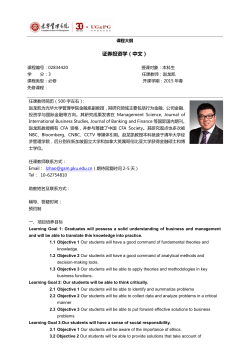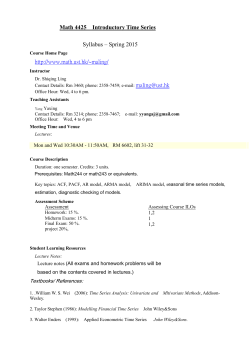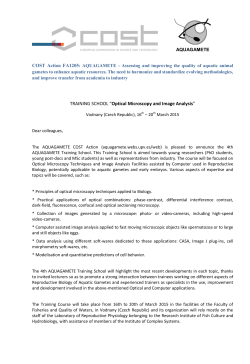
To make students aware that photonics is a rapidly growing field that
COURSE INFORMATION Course Title Photonics Code Semester L+P Hour Credits ECTS PHYS 656 2 4+0 4 10 Prerequisites - Language of Instruction English Course Level Postgraduate Course Type Elective Course Coordinator Prof. Dr. Rabia Ince Instructors Prof. Dr. Rabia Ince Assistant Goals To make students aware that photonics is a rapidly growing field that touches almost every field of research in science and technology, from laser manufacture to biological and chemical sensing, medical diagnostics and therapy, display technology, and optical computing. To ensure students realise that photonics was the basis for the telecommunications revolution over the past two decades and that its potential applications are virtually unlimited in nearly all research fields. Content Optical radiation, fibre optics, optical activity, non-linear optics, photonics in precision time and frequency metrology, non-linear laser spectroscopy, future applications. Teaching Methods Assessment Methods An understanding of the way optical radiation is detected, perceived and measured by humans. 1 ,2,12 A How optical radiation is quantified by the system international (SI) and its base unit. 1 ,2,12 A 1 ,2,3 A,B,C 1 ,2,3 A, B,C 1 ,2,3 B, C Learning Outcomes Ensuring students understand the working principles of novel instrumentation and techniques required for innovative photonic applications. Ensuring students understand modern applications of photonics An understanding of the great potential of photonics in spectroscopy An appreciation of the future applications of photonics 1 ,2,3 A Teaching Methods: 1: Lecture, 2: Question-Answer, 3: Discussion, 9: Simulation, 12: Case Study Assessment Methods: A: Testing, B: Presentation, C: Homework COURSE CONTENT Week Topics 1 2 Study Materials Optical Radiation: Photometry, radiometry and colorimetry in the SI Optical Radiation: Photometry, radiometry and colorimetry Fibre optics; fibre optic applications Fibre-optic gyroscope, Fibre3 optic bio and chemo-sensing 4 5 6 7 8 9 10 Optical activity, induced optical effects Lectures and resources Lectures and resources Lectures and resources Lectures and resources MidTerm Exam 1 Non-linear optics; frequency doubling, phase conjugation Lectures and resources Non-linear optics in quantum confined structures Lectures and resources Photonic crystals, the photorefractive effect; optical data storage I Lectures and resources Photonic crystals, the photorefractive effect; optical data storage II Lectures and resources MidTerm Exam 2 Opto-atomics: Optical cooling. atomic, optical lattice and ion clocks for Lectures , 11 precision time and frequency metrology resources, publications Non-linear laser spectroscopy, Raman, pump-probe, The Franz– 12 Keldysh and Stark effects: I Lectures and resources Non-linear laser spectroscopy, Raman, pump-probe, The Franz– 13 Keldysh and Stark effects: II Lectures and resources 14 Future applications: Metamaterials, &Quantum computing RECOMMENDED SOURCES Lectures, resources, publications Contemporary nonlinear optics, G.P. Agrawal, R. W. Boyd(ed) (1992) Textbook Fundamentals of photonics, E.A. Saleh, Malvin Carl Teich., Photonics and lasers : an introduction / R. S. Quimby, Essentials of photonics, Additional Resources Rogers, A. J. MATERIAL SHARING Documents Journal publications. Assignments Four homework assignments Exams Two mid-term exams and one final ASSESSMENT IN-TERM STUDIES NUMBER PERCENTAGE Mid-terms 2 30 Lab practicals 0 0 Assignment 4 10 Seminars 1 5 Total 45 CONTRIBUTION OF FINAL EXAMINATION TO OVERALL GRADE 55 CONTRIBUTION OF IN-TERM STUDIES TO OVERALL GRADE 45 Total COURSE CATEGORY 100 Expertise/Field Courses COURSE'S CONTRIBUTION TO PROGRAM No Program Learning Outcomes Contribution 1 2 3 4 5 1 Gets a sound base for the main fields of physics such as Classical Mechanics, Quantum Mechanics and Electromagnetism, 2 Gets the ability of interpreting, analysing, forming a synthesis and relationships between the main fields of physics and/or other sciences, 3 Obtains the education required for the measurements in scientific and technological areas and the contribution of physics in the industrial applications and on the macroscopic scale such as the society, 4 Follows the up-to-date scientific developments, makes the analysis/synthesis for the new ideas and evaluates them, 5 Uses the academic sources, the computer technology and the related devices, 6 Joins the working and research groups, also the scientific meetings, communicates well at the national and international level, 7 Gets the ability of creative and critical thinking, problem solving, researching, producing a new and original work, improving himself/herself in his/her own fields of interest, 8 Gains the concepts of ethics and responsibility. Undertakes the responsibility for the solutions to the problems related with his/her field as required for having an intellectual identity. ECTS ALLOCATED BASED ON STUDENT WORKLOAD BY THE COURSE DESCRIPTION Activities Quantity Total Duration Workload (Hour) (Hour) Course Duration (Including the exam week: 16x Total course hours) 16 4 64 Hours for off-the-classroom study (Pre-study, practice) 16 9 144 Mid-terms 2 2 4 Homework + presentation assignments 4 6 24 Final examination 1 2 2 Total Work Load 238 Total Work Load / 25 (h) 9.52 ECTS Credit of the Course 10
© Copyright 2025
















